The Behavioral Biometrics Market is estimated to be valued at USD 2380.7 million in 2025 and is projected to reach USD 18477.4 million by 2035, registering a compound annual growth rate (CAGR) of 22.7% over the forecast period.
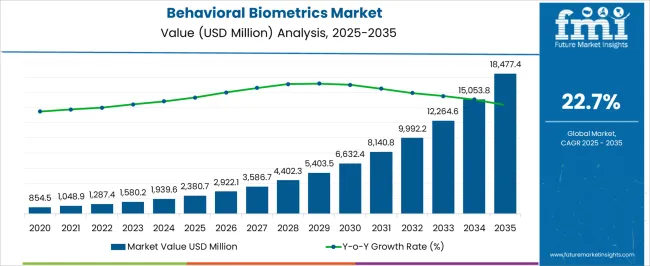
| Metric | Value |
|---|---|
| Behavioral Biometrics Market Estimated Value in (2025 E) | USD 2380.7 million |
| Behavioral Biometrics Market Forecast Value in (2035 F) | USD 18477.4 million |
| Forecast CAGR (2025 to 2035) | 22.7% |
The behavioral biometrics market is expanding rapidly due to the increasing need for advanced security solutions that address identity fraud and cybercrime. Rising digital transaction volumes and widespread adoption of online platforms have intensified the demand for authentication systems that are both seamless and secure.
Behavioral biometrics leverages unique patterns such as typing rhythm, mouse movements, and device interaction to deliver continuous authentication, thereby minimizing risks associated with credential theft. The adoption of artificial intelligence and machine learning has significantly enhanced accuracy and adaptability of these systems across dynamic threat landscapes.
Regulatory requirements for strong customer authentication in banking and financial services are further driving uptake. With enterprises focusing on reducing fraud losses while maintaining user convenience, behavioral biometrics is positioned as a key pillar of next generation cybersecurity frameworks.
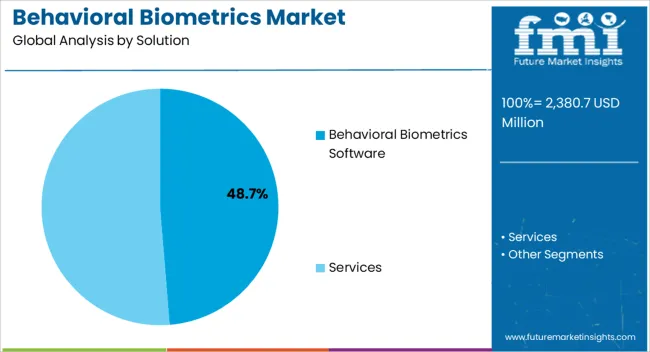
The behavioral biometrics software segment is projected to account for 48.70% of total revenue by 2025 within the solution category, positioning it as the leading segment. Growth in this area is being driven by its ability to deliver scalable, adaptable, and cost effective solutions without the need for additional hardware.
Software platforms provide real time analysis of user behavior, enabling seamless fraud detection and identity protection in digital transactions. The flexibility to integrate with existing IT infrastructure and compatibility across multiple platforms further strengthen adoption.
With rising sophistication of cyber threats, software based behavioral biometrics has emerged as the most effective and widely deployed solution, consolidating its dominance in the market.
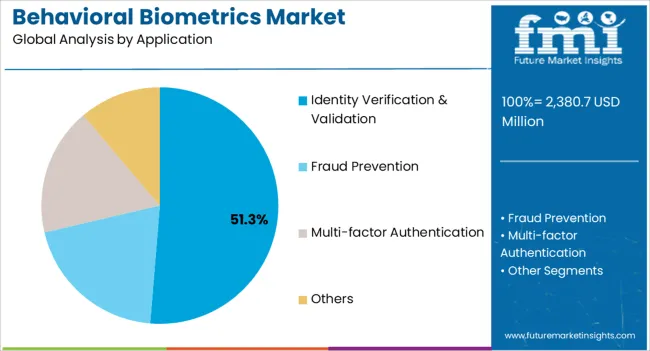
The identity verification and validation segment is expected to represent 51.30% of total market revenue by 2025 under the application category, making it the most prominent use case. Its leadership is driven by the rising importance of accurate and continuous verification in financial services, e commerce, and government systems.
The segment benefits from growing regulatory pressures to implement strong authentication measures, particularly in industries handling sensitive data. By offering passive, real time user validation, behavioral biometrics enhances both security and user experience.
Increased integration of identity verification into mobile banking and digital onboarding processes has further boosted demand, positioning this application segment as the cornerstone of market growth.
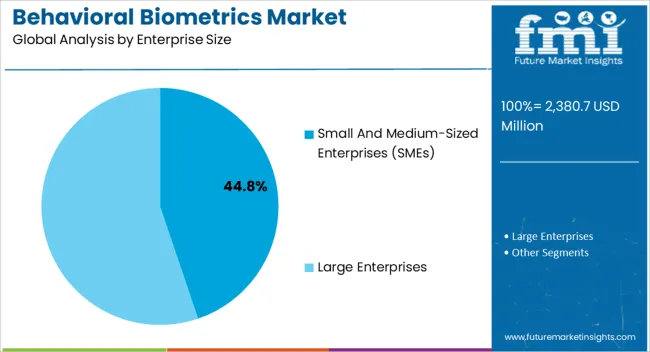
The small and medium sized enterprises segment is anticipated to capture 44.80% of total revenue by 2025 within the enterprise size category, highlighting its strong influence on market expansion. Adoption among SMEs is being accelerated by the need for affordable, scalable, and easy to implement cybersecurity solutions that safeguard business continuity.
Cloud based behavioral biometrics solutions are particularly attractive to this segment due to low upfront costs and simplified integration. SMEs are increasingly targeted by cyberattacks, which has amplified awareness and investment in advanced authentication technologies.
As digital transformation accelerates across this segment, behavioral biometrics has become integral in protecting customer trust, reducing fraud risk, and ensuring compliance with evolving security standards.
Frequent developments and the implementation of new technologies/software such as advanced behavioral biometrics technologies, human behavioral patterns, and machine learning/deep learning for identity verification and validation, fraud prevention, and multi-factor authentication applications are creating opportunities for growth of the behavioral biometrics solutions.
Advantages such as flexibility, convenience, efficiency, and security, which also facilitate integration with cloud solutions are primary factors resulting in higher demand for behavioral biometrics being used on a global scale. The integration of technologies such as the Internet of Things (IoT), big data, artificial intelligence (AI), and others can be expected to lead to development of the behavioral biometrics functionalities, with improved performance.
FMI predicts the behavioral biometrics demand to rise at a 23.8% CAGR between 2025 and 2035 in comparison to the 21.7% CAGR registered during 2020 to 2025. Biometric authentication software helps improving security for networks, applications, and physical locations through integration of biometric factors such as additional access qualifier. Biometric authentication tools uses physical characteristics including facial, fingerprint, or voice recognition to verify a user’s identity.
Higher integration of the technology will enable the global behavioral biometrics market reach USD 1,533.2 million in 2025, and eventually to USD 13,001.4 million by 2035.
Crucial Applications Banking Sectors to Propel the Market Growth
Behavioral biometrics are mainly used for analyzing a user’s cognitive behavior and digital-physical features. It is gaining traction across diverse industries as an effective fraud prevention solution. Behavioral biometrics helps in distinguishing between legitimate users and cybercriminals and verifies people by how they perform and interact online rather than by their physical characteristics.
Behavioral biometrics are adopted across a range of industries with a digital presence and are poised to play a crucial role in building digital trust and safety. Digital banking is one of the most effective platforms for financial institutions to drive growth, attract new customers, and increase revenue.
Behavioral biometrics offers various benefits in the banking sectors such as account opening protection, account takeover protection, and social engineering scam detection, among others. The reliability offered by behavioral biometrics solutions will push their uptake in the BFSI sector.
The Behavioral Biometrics Sector Now Has a Beneficial Income Stream Owing to Ddigitalization
Ongoing digitization has created a lucrative revenue stream for the behavioral biometrics industry wherein access, security, and privacy of data remains at top of the mind of all digitally-driven businesses. As password security has become vulnerable to breaches, businesses are seeking intelligent yet convenient security solutions to avoid fraudulent activities, financial losses, and market reputation.
Popular biometric technologies, ranging from fingerprint to facial recognition, have witnessed a demand uptick because they offer accurate, reliable, and cost-efficient security services. The reliance of enterprises on biometric technologies for security needs is set to fuel behavioral biometrics demand in the future.
United States to Take Over the North American Market
North America is predicted to remain one of the most attractive markets during the forecast period. According to the study, the United States accounted for 18.5% of the North American market share in 2025.
The United States is the largest market for behavioral biometrics due to the strong presence of some of the leading behavioral biometrics software and service providers. Implementation of behavioral biometrics creates unique records of individuals and helps in elimination of data duplication and fraud activities, thereby combating identity fraud. Hence, the demand for behavioral biometrics would increase across various organizations in the United States, during the forecast period.
High Adoption of IOT to Generate High Market Revenue in France
The behavioral biometrics demand in the France is expected to rise at a CAGR of around 27.5% over the forecast period. France is increasingly powered by Internet of Things (IoT), human behavioral patterns, smart sensors, machine learning/deep learning, smartphone technology, and peer-to-peer networks.
Governments in Europe are encouraging the use of face biometrics incorporated civil ID cards for issuing passports and driving license. This is one of the factors driving behavioral biometrics demand in France and elsewhere in Europe. Furthermore, the increasing demand for a multi-layered security approach in banking and financial institutions is anticipated to drive growth in the country.
Implementation of Sophisticated Technology to Boost the Indian Market
The sales in India are expected to increase at around 25.4% CAGR between 2025 and 2035. There is continuous development and implementation of new technologies/solutions such as behavioral biometrics software across organizations in India.
The proliferation of and real-time payment and mobile payment platforms in the country has augmented cases of fraud, which is fueling the demand for behavioral biometrics. In addition to this, financial solution providers in the South Asia & Pacific region are focusing on offering secured authentication solutions based on advanced behavioral biometrics technologies to their customers.
Beneficial Characteristics of Behavioral Biometrics Software to Propel Segment Growth
Based on solution, behavioral biometrics solutions are available as behavioral biometrics software and services. The behavioral biometrics software segment was valued at USD 2380.7 million in 2025, accounting for 54.5% revenue.
Behavioral biometrics software offers various benefits such as better user experience, fast and inexpensive deployment, flexibility, increased security, and are compliant with regulations.
Behavioral biometric authentication solutions identify a person based on human behavioral patterns exhibited when they interact with a device like smartphone, tablet, or computer with including mouse and keyboard.
Identity Verification & Validation Applications Segment to Generate Highest Market Share
By application, behavioral biometrics is segmented into identity verification & validation, fraud prevention, multi-factor authentication, and others. Rising awareness among organizations about the requirement to maintain the privacy of their data and counter the increasingly frequent and sophisticated cyber-attacks, identity-related fraud, malware, and data breaches targeted at their data is further expected to drive the identity verification & validation application segment growth.
Identity verification & validation application had the highest market share in terms of value in 2025 and is set to report a CAGR of 23.8% from 2025 to 2035.
The identity verification & validation solutions provide different authentication options to users based on their privilege levels. In June 2024, Incognia launched location-based behavioral biometrics solution to combat mobile fraud. Implementation of behavioral biometrics helps to fight the cybercrimes as well.
Adoption of Digital Payment Methods to Drive the Large Enterprises Segment Growth
The large enterprises segment accounted for 63.4% of the overall market share in 2025, and is expected to continue its dominance during the forecast period. Large enterprises have been focusing on implementing behavioral biometrics solution in their business applications to improve customer security and overcome infrastructure costs.
Emerging trend of online transactions is encouraging large enterprises large multinational banks and financial institution to adopt advanced and more sophisticated service platforms. Rising cases of cyber-attacks and sophisticated data theft are propelling the adoption of behavioral biometrics-based cybersecurity systems, which enable flexible authentication and persistent security, in the large enterprises.
Ease of Operation to Propel the Market Exapnsion of BFSI Segment
On the basis of industry, behavioral biometrics is segmented into banking, financial services and insurance (BFSI), retail and eCommerce, healthcare, IT & telecom, government and defense, and others.
The BFSI segment held the highest market share in terms of value in 2025 and is set to register a CAGR of 28% from 2025 to 2035. BFSI industry segment is expected to witness substantially high demand during the forecast period due to its advantages including ease of operation, flexibility, security, and cost proficiency.
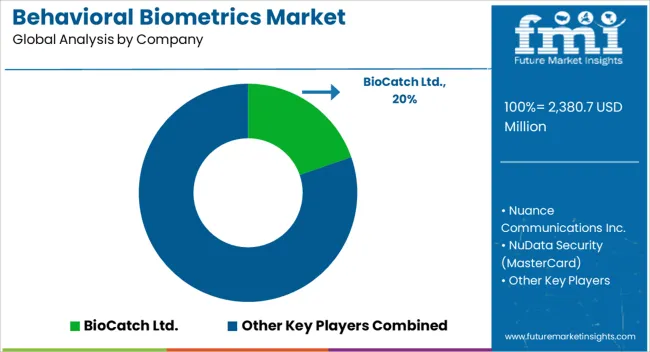
Implementation of behavioral biometrics facilitates secure authentication in financial institutions, businesses, government facilities and retail Point-of-Sale (POS), and in other environments. Behavioral biometric verification methods include keystroke dynamics, gait analysis, voice ID, mouse use characteristics, signature analysis and cognitive biometrics.
| Attribute | Details |
|---|---|
| Market Value in 2025 | USD 2380.7 million |
| Market Value in 2035 | USD 18477.4 million |
| Market CAGR 2025 to 2035 | 22.7% |
| Forecast Period | 2025 to 2035 |
| Historical Data Available for | 2020 to 2025 |
| Market Analysis | USD million for Value |
| Key Regions Covered | North America; Latin America; Europe; East Asia; South Asia; Oceania; Middle East & Africa |
| Key Countries Covered | United States, Canada, Brazil, Mexico, Germany, United Kingdom, France, Spain, Italy, India, Malaysia, Singapore, Thailand, China, Japan, South Korea, Australia, New Zealand, GCC Countries, South Africa, Israel |
| Key Segments Covered | Solution, Application, Enterprise Size, Industry, Region |
| Key Companies Profiled | BioCatch Ltd.; Nuance Communications Inc.; NuData Security (MasterCard); SecuredTouch Ltd.(Ping Identity); UnifyID (Prove); Fair Issac Corporation; BehavioSec Inc.; ThreatMark; Callsign Inc.; Adjust GmbH (AppLovin) |
| Customization & Pricing | Available upon Request |
The global behavioral biometrics market is estimated to be valued at USD 2,380.7 million in 2025.
The market size for the behavioral biometrics market is projected to reach USD 18,477.4 million by 2035.
The behavioral biometrics market is expected to grow at a 22.7% CAGR between 2025 and 2035.
The key product types in behavioral biometrics market are behavioral biometrics software, _cloud-based, _on-premise, services, _consulting services, _implementation services, _support & maintenance and _managed services.
In terms of application, identity verification & validation segment to command 51.3% share in the behavioral biometrics market in 2025.






Full Research Suite comprises of:
Market outlook & trends analysis
Interviews & case studies
Strategic recommendations
Vendor profiles & capabilities analysis
5-year forecasts
8 regions and 60+ country-level data splits
Market segment data splits
12 months of continuous data updates
DELIVERED AS:
PDF EXCEL ONLINE
Behavioral Health Market Forecast Outlook 2025 to 2035
Behavioral Analytics – AI-Powered Cybersecurity & Insights
AI-Powered Behavioral Therapy Market Size and Share Forecast Outlook 2025 to 2035
AI-Enabled Behavioral Therapy Market Size and Share Forecast Outlook 2025 to 2035
Military Biometrics Market Size and Share Forecast Outlook 2025 to 2035
Healthcare Biometrics Market Trends - Growth, Demand & Forecast 2025 to 2035
AI-enabled Biometrics Market
Fingerprint Biometrics Market by Authentication Type, Mobility, Industry & Region Forecast till 2035
Hand Geometry Biometrics Market Insights - Trends & Growth 2025 to 2035

Thank you!
You will receive an email from our Business Development Manager. Please be sure to check your SPAM/JUNK folder too.
Chat With
MaRIA